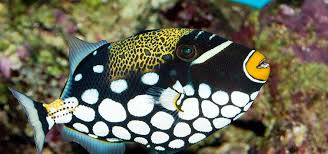Clown Triggerfish (Balistoides conspicillum)
• Small fish safe: ❌ No (highly predatory, may attack smaller fish)
• Small invert safe: ❌ No (will eat crustaceans, mollusks, and other invertebrates)
• Coral safe: ❌ No (may damage coral while foraging)
• Minimum tank size: 530 liters (140 gallons) for juveniles, 750+ liters (200+ gallons) for adults
• Adult size: Up to 50 cm (20 inches)
• Diet: Carnivorous, feeding on crustaceans, mollusks, sea urchins, and small fish
• Be aware of: Highly aggressive and territorial; will eat smaller tank mates; strong jaws capable of breaking shells and even biting reef keepers
Appearance and Coloration
The Clown Triggerfish is one of the most strikingly patterned marine fish in the hobby. Its bold black body is decorated with large white polka dots on the lower half, while the upper portion features a yellow and black leopard-like pattern. The mouth is ringed in bright yellow, and a yellow band runs behind the eyes. This eye-catching coloration helps it blend into coral rubble in the wild while also making it a centerpiece in aquariums.
Natural Habitat and Behavior
Native to the Indo-Pacific region, Balistoides conspicillum inhabits tropical coral reefs and rocky lagoons at depths of 1 to 75 meters (3 to 250 feet). It prefers areas with plenty of caves and overhangs for shelter.
In the wild, Clown Triggerfish are solitary and highly territorial, often defending a specific area from intruders. Their strong jaws allow them to crush hard-shelled prey, including crabs, snails, and sea urchins. They are also known for rearranging their environment, moving rocks and shells as they establish their territory.
Tank Requirements and Water Parameters
• Minimum Tank Size: 140 gallons (530 liters) for juveniles, 200+ gallons (750+ liters) for adults
• Water Parameters:
• Temperature: 24°C – 28°C (75°F – 82°F)
• pH: 8.1 – 8.4
• Specific Gravity: 1.020 – 1.025
• Aquascaping:
• Provide sturdy rock formations and caves for shelter.
• Avoid loose rocks, as Clown Triggers are known to move objects in their tank.
• Open swimming areas are essential for their active, powerful swimming style.
• Lighting: Moderate to bright reef lighting is acceptable.
• Water Movement: Moderate to strong, simulating their natural reef environment.
Diet and Feeding
Clown Triggerfish have powerful teeth designed for crushing shells and require a protein-rich diet.
• Natural Diet: Hard-shelled invertebrates such as crabs, snails, shrimp, sea urchins, and small fish.
• Captive Diet:
• Chopped seafood (shrimp, squid, clams, mussels).
• Frozen marine foods designed for carnivorous fish.
• Hard-shelled foods (mussels, whole shrimp, snails) to help wear down their continuously growing teeth.
• High-quality marine pellets and flakes (as supplements).
Feeding Frequency: 2-3 times per day to support their high metabolism.
Compatibility and Social Structure
• Temperament:
• Highly aggressive and territorial, particularly as they mature.
• Can become the dominant fish in the tank, potentially harassing tank mates.
• Tank Mates:
• Best housed with large, equally aggressive fish, such as:
• Groupers
• Large puffers
• Large angelfish
• Other triggerfish (only in very large tanks)
• Avoid keeping with small fish, shrimp, or crabs, as they will be eaten.
• Not recommended for community or peaceful tanks.
• Reef Compatibility: ❌ Not reef-safe—will eat invertebrates and may damage corals.
Important Considerations
• Extremely Aggressive: Clown Triggerfish become more aggressive with age, so plan for long-term compatibility.
• Biting Behavior: They are known to bite hands or aquarium equipment, so use caution when performing maintenance.
• Tank Rearrangement: Clown Triggers may move rocks and objects as they establish their territory.
• Teeth Growth: They require hard-shelled food (such as mussels or snails) to naturally wear down their teeth.
• Tank Size Matters: A minimum of 200 gallons is recommended for a full-grown adult due to their size and activity level.
